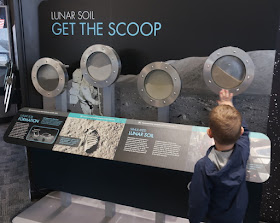We made another trip to NASA's Goddard Space Flight Center. The visitor center is one of the locations for Agents of Discovery, a mobile-device based activity that we have done before. So we enjoyed the exhibits, the gift shop, and discovering some new facts.
My children liked getting on the concrete barriers at the front of the building. The lady at the front desk told us not to climb on them, so I guess this is the last picture of that activity.
Inside, we saw a sign that had different messages when looking through different colored filters.
Different types of soil are found on the lunar surface. Dust, volcanic soil, and meteor remains are all found on the moon.
Also on the moon are footprints. We tried out the replica on display. None of us measured up to the Apollo 14 astronauts.
Another display has models showing how the Hubble Telescope was repaired back in the day. I miss our old shuttle system.
One display explains satellite mapping by having visitors bounce a pinball off a surface. The way the ball returns mimics the way satellite signals are reflected by the Earth's surface.
The Lunar Reconnaissance Orbiter has a copy on display. The many instruments it uses to observe the moon are described, along with interactive panels. My kids weren't so interested in this.
My children really enjoyed the infrared camera display. The pictures include a regular camera and the infrared.
We started the Agents of Discovery challenge, only to find that the QR reader on the app wasn't working. So the indoor discoveries went undiscovered.
Outside, the app worked better. At the Delta-B rocket, we read how it was used to deliver over 200 payloads into orbit. The app asked us what nickname was given to this rocket. We found the answer easily on the sign describing it.
From the rocket plaza we could see the flight center in the not-to-far distance.
Another outdoor challenge was to use the directional sign by the gift shop to see which NASA center was farthest away.
One interesting form of scientific detection is the Ozone Bio-Indicator Garden. The display tells how plants are effected by lower ozone layers. The plants are grown right next to the sign, enabling us to make our own observations.
We took one last set of photos before buying some astronaut ice cream (the dehydrated kind) at the gift shop.
 |
| Entrance to the visitor center |
My children liked getting on the concrete barriers at the front of the building. The lady at the front desk told us not to climb on them, so I guess this is the last picture of that activity.
 |
| It says "No Parking," not "No Sitting" |
Inside, we saw a sign that had different messages when looking through different colored filters.
 |
| Unfiltered message |
 |
| Red-filtered message |
Different types of soil are found on the lunar surface. Dust, volcanic soil, and meteor remains are all found on the moon.
 |
| Lunar soil exhibit |
Also on the moon are footprints. We tried out the replica on display. None of us measured up to the Apollo 14 astronauts.
 |
| Big shoe to fill |
Another display has models showing how the Hubble Telescope was repaired back in the day. I miss our old shuttle system.
 |
| Doing repairs |
One display explains satellite mapping by having visitors bounce a pinball off a surface. The way the ball returns mimics the way satellite signals are reflected by the Earth's surface.
 |
| Satellite pinball |
The Lunar Reconnaissance Orbiter has a copy on display. The many instruments it uses to observe the moon are described, along with interactive panels. My kids weren't so interested in this.
 |
| LRO |
My children really enjoyed the infrared camera display. The pictures include a regular camera and the infrared.
 |
| Posing for the infrared camera |
 |
| What the regular camera saw |
 |
| What the infrared camera saw |
We started the Agents of Discovery challenge, only to find that the QR reader on the app wasn't working. So the indoor discoveries went undiscovered.
 |
| I did find the QR code, Mr. Squirrel |
Outside, the app worked better. At the Delta-B rocket, we read how it was used to deliver over 200 payloads into orbit. The app asked us what nickname was given to this rocket. We found the answer easily on the sign describing it.
 |
| A hard working rocket |
From the rocket plaza we could see the flight center in the not-to-far distance.
 |
| Where the work gets done |
Another outdoor challenge was to use the directional sign by the gift shop to see which NASA center was farthest away.
 |
| Various NASA bases |
One interesting form of scientific detection is the Ozone Bio-Indicator Garden. The display tells how plants are effected by lower ozone layers. The plants are grown right next to the sign, enabling us to make our own observations.
 |
| Information |
 |
| These plants are out of season or completely sensitive to ozone variances |
 |
| Tobacco still grows strong |
We took one last set of photos before buying some astronaut ice cream (the dehydrated kind) at the gift shop.
 |
| Sticking her neck out |
 |
| Our man in space |
 |
| A two-headed monster? |
 |
| Yes indeed |
No comments:
Post a Comment